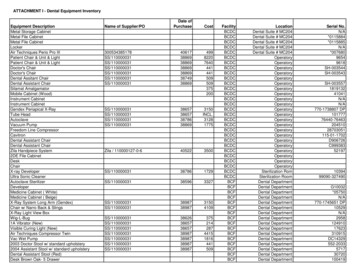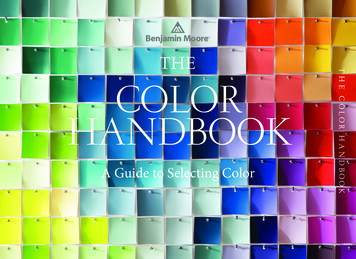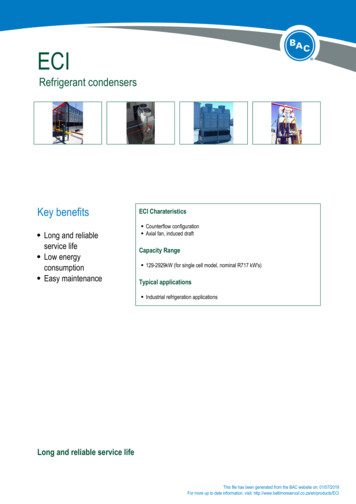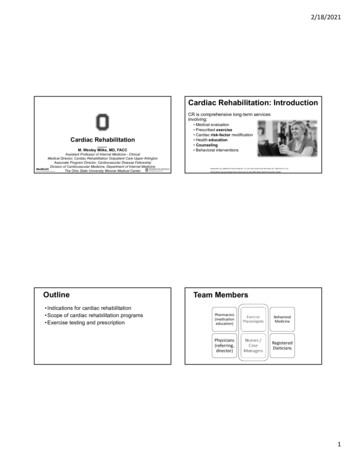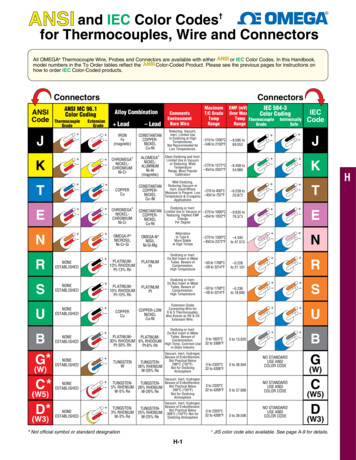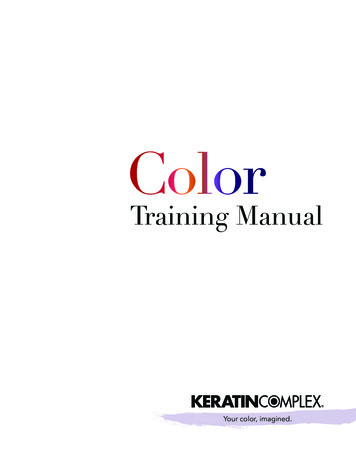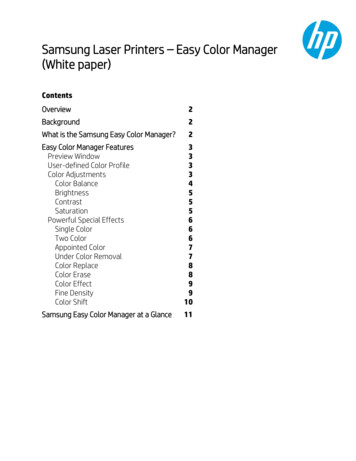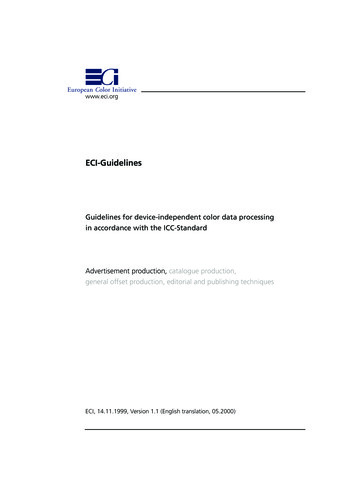
Transcription
www.eci.orgECI-GuidelinesGuidelines for device-independent color data processingin accordance with the ICC-StandardAdvertisement production, catalogue production,general offset production, editorial and publishing techniquesECI, 14.11.1999, Version 1.1 (English translation, 05.2000)
ECI-Guidelineswww.eci.orgContentsForeword1. Objectives of the »European Color Initiative«2. Objectives and Contents of the ECI-Guidelines3. Commitment to Supporting the ICC-Standard4. Establishing the Proof4.1 »Idealized ICC-Proof«4.2 »ICC-Proof« (»ICC Contract Proof«)4.3 »ICC-Proof with Generic Profiles« (»ICC Contract Proof«)4.4 »ICC-Soft Proof«4.5 Proprietary Digital Proof Methods5. Administrative Communication between »Data Supplier« and »Data Receiver«6. Basic Workflow for Digital Processing of Printed Material7. Technical Specifications for the Exchange of Advertisement Files7.1 Exchange Format7.2 Exchange Color Spaces7.3 Overprinting and Trapping7.4 Process and Data Control7.5 Proofs7.6 Data Exchange Media8. Technical Specifications for the Exchange of Files for Catalogue Production8.1 to 8.x9. Technical Specifications 9.1 to 9.xAppendix 1: Recommendations for the Adaptaion of ICC-Workflows in Advertising ProductionAppendix 2: Recommendations for the Adaptation of ICC-Workflows in Catalogue ProductionAppendix 3: Recommendations for the Adaptation of ICC-Workflows in General Offset ProductionAppendix 4: Recommendations for the Adaptation of ICC-Workflows in Editorial and Publishing TechniquesAppendix 5: Process Control –The Ugra/FOGRA Media Wedge–Appendix 6: »MediaStandardPrint« (not included)Appendix 7: The Corner Points of the ICC-StandardAppendix 8: »The 10 Commandments of Color Managements«Appendix 9: Example of a Measuring File in Accordance with the Color Chart ISO 12642 (IT8.7-3)Note: Grey chapters are in planningPage 2
ECI-Guidelineswww.eci.orgForewordDigital color data processing in the communication industry has changed. The idea of reproducing colorstipulatory and maintaining predictable and constant color information in all stages of processing is not newbut technological changes call for new methods to put this into practice.In traditional closed production cycles, color information, from beginning to end, was edited purely according to the process and device-dependently. Modern production environments however, are characterisedby open, modular, fully-digital system environments. Increasing exchange of data, multiple usage of colordata and unpredictable means of production make device-independent concepts of colour processing necessary. Put another way: Fully-digital system environments allow for new, efficient methods of working withcolor information.In classical, CMYK-based reproduction technology, process-inherent alterations to color information werecompensated for with the mutual balancing (linearization, calibration, exchange of characteristics) of peripherals and stages of process. As a rule, brightness and dot coverage information alone, such as gradationcurves, copier and printing characteristics, were transported through the proprietary production process.(»densitometric-based color communication«). This method required that all the systems involved workedwith the same primary color system (CMYK) and that the means of production, above all the target outputmedium with its characteristics of color reproduction (e.g. a particular printing process, a particular type ofpaper) were already known when digitizing artwork.Densitometric-based color communication does not work in modern production environments consisitng ofsystem components with different primary color systems. For this reason a new strategy for color processingwas developed known as »Color Management«. All input and output systems or partial processes involvedin the production process are characterized in relation to a device-independent colorimetric reference system.These colorimetric device and process descriptions are saved as so-called »color-profiles«. Color informationof an image, when being digitized or finished for a particular output medium, can be converted with individual color-profiles to the process components’ different primary color systems.In 1993 the »International Color Consortium« established a standard for a universal, platform-independentstructure for such color-profiles. At the same time it commissioned the development of a »Color-Management-Framework« to allow for color transformations centrally in the operating system according to the ICCstandard and to be accessible for all hardware and software developers. In this way it is possible to exchangeICC-color profiles, to carry out any process-specific color adjustment on any platform at any time in the reproduction workflow and to exchange color data with a consistent definite colorimetric reference (i.e. theappropriate color-profile). Alongside the main objective to »organize« color even in open system environments, workflows can be automated with ICC-technology, labour can be optimized, costs reduced, technicalcolor processing improved and thereby the quality of color reproduction increased.For the user this change in color data processing means a reorganization of his reproduction workflows. Process-specific CMYK-data, due to their comparable small color range as archive color space, are not suitablefor processing in variable production systems or the multiple use of data for different output media. Colordata nowadays must be saved and processed device-independently. These guidelines were drawn up by the»European Color Initiatve« (ECI) and deal with the introduction of efficient ICC-workflows in reproductiontechnology based on the ICC-standard.Page 3
ECI-Guidelineswww.eci.org1. Objectives of the »European Color Initiative«The »European Color Initiative« (ECI) was founded in 1996, it is an amalgamation of international agencies,creative and technical pre-press businesses, printing houses, publishers and research institutes,(http://www.eci.org). The most important objective of the ECI is to promote the exchange of device-independently processed color data and to introduce efficient color management workflows based on the ICC-standard into advertisement production, editorial and publishing techniques, catalogue production and generaloffset production. To realize this objective, the following have been undertaken: The establishment of suitable data formats for the exchange of (print)data, prepared according to the ICCconvention. The harmonization of data exchange formats in respect of their ICC-compatibility and their suitability forsaving device-independent color data. Formulation of request catalogues to hardware and software developers in the publishing industry. Formulation of request catalogues to technical standardization groups, e.g. the ICC. Drawing up of the »ECI-Guidelines« for promoting the introduction of ICC-workflows in the industry. Measures for training in businesses according to the ECI-Guidelines. The elaboration of a certification system for businesses that work according to the ECI-Guidelines. Publication of a list (»Yellow Page«) of all certified businesses.2. Objectives and Contents of the ECI-GuidelinesThis document should help the »user« to set up productive ICC-workflows, to automate device-independentcolor processing and to organize safely the exchange of ICC-capable color data. The contents divide intotwo blocks:The first block (in Sections 7 to x) establishes »Technical Specifications for the Exchange of Color Data«between pre-press and the printing house. The specifications (data format, color space etc) are (first of all)defined differently for the main production areas »advertisement production«, »catalogue production«,»editorial and publishing techniques« and »general offset production«. They should ensure that the datacan be further processed by the receiver without problem in ICC-based workflows.In the second block, recommendations for the adaptation of ICC-workflows are given in the appendix.These recommendations are, among other things, orientated around the latest available hardware and software and their functions. This block has the objective to show the »beginner« how ICC-color managementcan be realized today in the main production areas mentioned.These guidelines do not have the primary objective to stipulate the job data sent between »data supplier«and »data reciever« (e.g. with regard to format, print volume, color rendition etc.). The only exception is theICC-information for exchange data and proofs. In order to ensure the viability of all persons and processesinvolved in the ICC-workflow, recommendations are made as to which ICC-information (utilised profiles etc.)should be passed on to the data receiver.Page 4
ECI-Guidelineswww.eci.orgIn 1997 the »Bundesverband Druck« (Federal Association of Printers) published »Media-Standard Print«.While the media-standard describes different modular components and modules such as data format, colorspaces, profiles, process control, measuring techniques and standards, and » these are to be used autonomously and properly by the user «, the ECI-Guidelines establish technical specifications for the exchange ofcolor data (data format, color space etc.) and aid the setting up of ICC-workflows for device-independentcolor processing. The measures described in »Media-Standard Print« for process control should be used fordigital workflows in accordance with the ECI-Guidelines.3. Commitment to Supporting the ICC-StandardThe members of the »European Color Initiative« (and the businesses certified in accordance with the ECIGuidelines) commit themselves to the total support of the ICC-standard. This means, above all, the production and use of color profiles containing entries on the basis of the Default-Data-Area (»Required Tags«,»Optional Tags«), which are defined in the ICC-specifications. Manfucturer-specific »Private Tags«, notdefined by the ICC, should not be supported. Analogous to this, only fully ICC-compatible CMMs (ColorMatching Module) should be used that can process all entries without problem in the default-sector of theICC-profiles.The CMM influences the color transformation. The CMMs available on the market produce different resultsfor color matching, due to varying curves in the conversion process or interpolation. The ECI recommendsthe use of »ColorSync 3.x« with the Apple-Default-CMM on Macintosh and Windows platforms which is toa degree publicly documented.Members should carry out all arising color transformations exclusively with ICC-profiles and thereby use theoperating system’s ICC-mechanism or other ICC-compatible transformation techniques, e.g. under PostScript-Level-2/3.All printing houses that are either members of the ECI or work according to the ECI-Guidelines provide theirpreferred ICC-profiles for edition printing on the ECI server. The profiles are then available for all involved onthe homepage: »http://www.eci.org«. The following data should be contained in the profile-packet: the ICC-CMYK-profile with the date in the file name an information file to the ICC-profile with the following details- printing house’ address and contact- date of profile production- printing process (e.g. sheet-fed offset, rotary offset, gravure etc.)- measuring technique used- measuring conditions for the profile production(recommendation: one-sided print out of test chart, measuring conditions according to ISO 13655: CIELAB, 0/45 or 45/0, D50, 2 . Exception: Underlay for measuring the test chart 3 sheets of edition paper, orleast white paper)- software used for profile production- separation settings: UCR/GCR, black ink limit, total ink limit etc.- the default CMM set in the profile(recommendation: Apple-Default-CMM as of ColorSync 3.x for Macintosh and Windows)Page 5
ECI-Guidelineswww.eci.org the ICC-profile’s CIELAB-measuring data based on the color chart ISO 12642 (IT8.7-3, example: see Appendix 8). The characterization chart with the measurement data must contain at least the measured CIELABvalues, the CMYK-values, the correct alphabetical and numerical indicators of the measurement areas aswell as a completed File-Header. An information file with recommendations as to how the measurement data is calculated, if necessary, asan ICC-profile (software, profile size, separation settings: UCR/GCR, black ink limit, total ink limit etc.). Thisinformation is covered in part by those given for the produced ICC-profile.All those involved who carry out color transformations for different printing houses can either use the ICCprofiles on the ECI server or produce appropriate ICC-profiles according to the printer’s characterizationcharts (measuring data) and use these for the color adjustment. The recommendations for producing theprofiles (black generation etc.) should be hereby considered.It is the responsibility of the printing houses to always provide up-to-date ICC-profiles or characterizationcharts on the ECI server, and the responsibility of those involved to call up the up-to-date profile. As a rule,thegravure printing houses provide their individual ICC-profiles on the ECI server. Many printing houses printaccording to one printing standard, e.g. BVD/FOGRA (corresponds extensively to DIN/ISO 12647-2) and donot provide individual ICC-profiles. Reproduction businesses can, in agreement with the printing house, usea generic ICC-profile for color adjustment and proofing, e.g. ICC-profiles based on the FOGRA-characterization charts for different paper classes. The data and some profiles for this can be called up on the ECI server(http://www.eci.org*) or at »http://www.fogra.org«.*future address of the ECI homepage. If necessary »http://www.kommtech.uni-wuppertal.de/eci« is still valid.Page 6
ECI-Guidelineswww.eci.org4. Establishing the ProofA proof is the material, color illustration of files and serves as a data control. Different control criteria makesense in the different phases of the production of a print file. On one hand the visualization of material,structural properties is to the fore, on the other the stipulatory color simulation of the printed result is calledfor. In the following, the points for usage, control functions, manufacture conditions and responsibilities arestipulated for different proof variations that appear in the ICC-workflows as described by the ECI.Generally, every ICC-proof should contain a footnote with at least the following information: Date and time of production correct file name of the data simulation for which printing house / printing process? ICC-source profile (correct profile-file name) ICC-target profile (correct profile-file name) if necessary, the ICC-simulations profile (correct profile-file name) proofing systemFor use with proprietary proofing systems, the proof’s footnote should contain the following entries: Date and time of production correct file name of the proofed data simulated printing process, if necessary the color adjustment curve used proofing system, if necessary the date of the last linearizationWhen working with a »JobTicket« (see Chapter 5), all proof-information cán be stored in the JobTicket-file.In this case, each proof should be marked with an identification number / contract number which refers tothe appropriate JobTicket.4.1 »Idealized ICC-Proof«What is understood here by »idealized ICC-proof« is the print-out of LAB-data or also of »standard«-RGBdata (referred to as »ECI-RGB« in the following) with the proofing system’s maximum color range of (»FullGamut-Proof«). It serves for the agreement on the structuring of contents of files, for example of adverts,between a creative agency and an art studio or a repro department. The »idealized ICC-proof« does not represent the expected color in the printed result. With this expressed, the LAB-proof can also serve for theagreement on correction with the client (e.g. advertising customer).The »idealized ICC-proof« can be made directly from the application file (e.g. Photoshop or QuarkXPress)When producing the idealized proof, the LAB-data or ECI-RGB-data to be printed should be transformedwith appropriate ICC-profiles to the proofer’s (color printer’s) color space and then printed out (diagrams 4.11 and 4.1-2). The ICC-color reproduction option »perceptual« can be used for pixel images. The print resultin its color range is LAB or ECI-RGB, “cropped” by the proofer’s actual, depictable CMYK-color space.Page 7
ECI-Guidelineswww.eci.orgEspecially the CMYK-color ranges of proofers are relatively large in comparison to the attainable color rangesof traditional printing processes. In no case should the LAB or ECI-RGB-data be printed out on the prooferwithout the appropriate ICC-transformation, otherwise an internal conversion to an unclearly defined CMYKspace will occur, either in the application software, printer driver or in the output device’s PostScript RIP, andthe CMYK produced will not be representative of the proofer’s complete color range.The Ugra/FOGRA CIELAB-media wedge should be proofed together with the print-out. This wedge (LABD50) should, if necessary, be transformed for now with the appropriate ICC-profile and the »relative colorimetric« reproduction option to the color space of the pixel image (e.g. ECI-RGB, LAB D65) and then with theappropriate ICC-profile and the same method (»perceptual«) as used for the transformation of the pixel image to the proofer’s color space (diagrams 4.1-1 and 4.1-2).Advertisement motif(LAB D50)CIELAB-media wedge(LAB D50)Advertisement file(LAB D50)ICCSP: LAB D50TP: Proofer-CMYK»Idealized ICC-proof«(CMYK)Diagram 4.1-1:»Idealized ICC-proof«,proofing LAB-DataCIELAB-media wedge(LAB D50)ICCTP: ECI-RGBSP: LAB D50»Media wedge«(ECI-RGB)Advertisement file(ECI-RGB)importICCTP: Proofer-CMYKSP: ECI-RGB»Idealized ICC-proof«(CMYK)Diagram 4.1-2:»Idealized ICC-proof«,proofing ECI-RGB-DataSP: »source-profile«, TP: »target-profile«Seite 8
ECI-Guidelineswww.eci.org4.2 »ICC-Proof« (»ICC Contract Proof«)The »ICC-proof« shows the color and material simulation of the edition print in a specific printing processwith a particular type of paper. Above all it serves as a contract proof for the printing house but also, forexample, for the agency, client or the publishers as a visualization of the color range to be expected in print.This proof should simulate the following criteria of the edition print as precisely as possible (within a tolerance agreed on by all involved):- the color appearance of images, graphics, special colors (visual judgement),- the dot gain or tonal changes (implicitly in images, graphics, colors),- the paper tone,- process-inherent features such as loss of tones in highlights,- if necessary the colorimetric measured values (e.g LAB, XYZ) of the chromatic color areas of the proofedUgra/FOGRA-CMYK-media wedge (evaluation of measurements).The ICC-proof should be made by the data producer / data supplier from the prepared transfer data (PDFexchange file) and passed on to the receiver together with the digital data. For the purpose of a data-outputcontrol, the data should preferably be proofed directly from the transfer data carrier. In this way it can bedetermined whether all necessary resources (fonts, high-resolution data etc.) are at hand.When producing the proof the color data should be transformed with appropriate ICC-profiles from thesource color space via the simulation color space (production print process) to the target color space(proofing system) (diagram 4.2-1). For this, the ICC-profile for the individual production print process shouldbe used as the simulation profile. For ICC-proofs on paper that corresponds to the edition paper of the production print, the »perceptual« ICC-rendering intent should be used for the transformation stage from thesource color space to the simulation color space (production printing) and »relative colorimetric« for the stage from the simulation color space to the target color space (proofer).Note: if the data is already in an adjusted composite-CMYK for an edition printing process then the firsttransformation stage is omitted. The CMYK-data should then be converted with the appropriate ICC-profileto the proofer’s color space (diagram 4.2-2). When printing on paper which corresponds in color to the edition paper, the »relative colorimetric« rendering intent should be used, otherwise the »absolute colorimetric«.One of the Ugra/FOGRA media wedges should be proofed together with the print-out. The wedge shouldbe already layed down in the exchange file and in the data’s color space. If the image data is in the LAB color space then the Ugra/FOGRA CIELAB-media wedge (LAB D50) can be implemented in the file without further ICC-transformations. If the exchange data, for example, is in the ECI-RGB color space, then the Ugra/FOGRACIELAB-media wedge should be transformed with the appropriate ICC-profiles and the »relative colorimetric« reproduction option to the ECI-RGB color space and imported into the exchange file. If the exchangedata is in an adjusted composite-CMYK, then the Ugra/FOGRA CMYK-media wedge TIFF from FOGRAshould be imported into the exchange file without further ICC-transformations.Page 9
ECI-Guidelineswww.eci.orgCIELAB-media wedge(LAB D50)ICCTP: ECI-RGBSP: LAB D50CIELAB-media wedge(LAB D50)Advertisement motif(LAB D50/ECI-RGB)»Media wedge«(ECI-RGB)PDF-file(LAB D50/ECI-RGB)(e.g. via PS)TP: Proofer-CMYKICC»or«SP: LAB D50/ECI-RGB»ICC-proof«(CMYK)Advertisement motif(e.g. gravure CMYK)SiP: e.g. gravure CMYKDiagram 4.2-1:»ICC-proof«,proofing CIELAB-Data orECI-RGB-DataCMYK-media wedge(TIFF)PDF-file(e.g. gravure CMYK)(e.g. via PS)ICCSP: e.g. gravure CMYKTP: Proofer-CMYK»ICC-proof«(CMYK)Bild 4.2-2:»ICC-proof«,proofing CMYK-DataSP: »source-profile«, SiP: »simulation-profile«, TP: »target-profile«Page 10
ECI-Guidelineswww.eci.org4.3 »ICC-Proof with Generic Profiles« (»ICC Contract Proof«)In principle, this proof is produced in the same way as the »ICC-proof« described in section 4.2. The maindifference is the simulation-profile that is used. Under otherwise identical conditions (rendering intents),appropriate »generic ICC-profiles« are used as simulation-profiles after agreement between the data supplierand data receiver, for example the ICC-profile for the »reference color space gravure« or the ICC-profile according to DIN/ISO 12647-2 (BVD/FOGRA offset-standard). Generic profiles, in this context, describe allthose profiles which have been produced on the basis of a printing norm or with characterization data standardized by many businesses.Because the color separation of CIELAB, ECI-RGB or also standard CMYK-data for the actual edition print isnot necessarily done with the generic profiles used for the proof, but with manufacturer-specific profiles, the»ICC-proof with generic profiles« only simulates the edition print approximately. If, for example, an advertisement is delivered to a number of publishers in LAB-PDF format, the agency / repro department can pass onan »ICC-proof with generic profiles« to the publishers instead of an »idealized proof«.If the exchange data, however, is separated for the edition print with the generic profiles used for the proof,then the proofed result represents precisely the production print. The »ICC-proof with generic profiles«hereby becomes the »ICC-proof« as described in section 4.2.4.4 »ICC-Soft Proof«What is understood here by »ICC-soft proof« is the simulation of the expected print result of color data onthe monitor. Above all it assists the scanner operator in the color assessment of the file in the process-specific preview-mode.Note: for the display of a soft proof, the digital color data is converted internally (temporarily) in the runningsoftware application with appropriate ICC-profiles from the source color space (e.g. ICC-scanner profile)through the simulation color space (printing process) to the monitor’s color space (individual ICC-monitorprofile). For the depiction of the paper tone, the »absolute colorimetric« reproduction option should be usedfor the transformation stage between simulation color space and the monitor color space. If the paper toneis not to be simulated then the »relative colorimetric« should be used for this tranformation stage. For theconversion stage between the source color space and simulation color space, »perceptual« is mostly chosenin both cases.Page 11
ECI-Guidelineswww.eci.orgAdvertisement motif(LAB D50/ECI-RGB)TP: monitor-RGBICCSP: LAB D50/ECI-RGBSiP: gravure CMYK»ICC-soft proof«(monitor-RGB)Diagram 4.4-1:»ICC-soft proof«,CMYK-preview of CIELAB-dataAdvertisement motif(e.g. gravure CMYK)ICCSP: e.g. gravure CMYKTP: monitor-RGB»ICC-soft proof«(monitor-RGB)Diagram 4.4-2:»ICC-soft proof«,true color depiction of CMYK-DataSP: »source-profile«, SiP: »simulation-profile«, TP: »target-profile«4.5 Proprietary Digital Proofing MethodsIn the category of »proprietary proofing methods« fall all those color adjustment systems (software solutions)that do not work on the basis of color profiles according to the ICC-standard. These systems are not recommended by the ECI. The exchange of the color adjustment curves or mechanisms for the different printinghouses is limited, even between proofing systems of the same type, because as a rule they are dependent on the printing material (paper tone) used with the proofer because they possess extensive editing functions with which it is possible to produce a proof result whichcannot be met in print with the digital color data. For ICC-based proof processes, the same ICC-profileshould be used for the color simulation and the separation of the digital data for the production print.Should the proprietary proofing process be used however, then the same criteria apply as for the contractproof described in section 4.2. But because the ICC-profile format is platform and hardware independent,the actual proof printers can be ICC-profiled and so used for ICC-based proofing processes.Page 12
ECI-Guidelineswww.eci.org5. Administrative Communication between »Data Supplier« and »Data Receiver«Important information for the data receiver about the exchange data and instructions for its finishing (e.g.job data, printing instructions etc.) can vary greatly in different production scenarios (e.g. advertisement production, catalogue production). Their content and the ways of communicating them are not layed down inthese guidelines. The only exception is ICC-information to ensure a faultless, ICC-based finishing of thetransfer data. This section establishes which ICC-information needs to be passed on to the data receiverabout the exchange data and the ICC-proofs which are supplied with itAll information and regulations for the exchange data can, in the future, be organized with a universal,extensive, digital »JobTicket«, which is being developed in co-operation by the software manufacturers »Callas«, »ZMG« and »Hermstedt« as well as the ECI team »JobTicket«. The JobTicket’s task, among otherthings, is to document administrative and technical descriptions of the prodcution data – from the planningand organization through creation and finishing to output. Today the almost exclusively fully-digital production environment in the media industry provides a good base for collecting, as far as possible, all relevantinformation fully automatically with suitable query and input processes. This has the advantage that onlyauthentic information finds its way into the JobTicket.To ensure that the data receiver can finish the transfer data correctly and true to color in his ICC-workflow,the following information (along with individual contract information) should be enclosed with the file andICC-proof:1. Concerning the file Color space of data in exchange file (according to the specifications in Chapter 7) ICC-color transformation- Target-profile (correct file name)- Target-profile (supplied in addition / embedded)2. Concerning the ICC-proof Description of proofing system ICC-transformation- Source-profile- Rendering intent- Target-profile- Simulation-profile (if applicable)- Rendering intent (if applicable)The ICC-entries in the exchange file should also be documented for all other ICC-processed intermediatedata and passed on internally to the next colleague. If a JobTicket is not being used then the ICC-information can be conveyed in a PDF-form which can be made interactive with input fields, buttons and blendin menus.Page 13
ECI-Guidelineswww.eci.org6. Basic Workflow for Digital Processing of Printed MaterialIf one looks at the modern, technical »journey through life« of a print file, one can see that regardless of thetype of printed material (advertisements, catalogues, magazines, prospectuses, jobbing work, newspapers), itis in principle always made up of the same partial processes:In a creative phase an »idea« is nowadays usually converted to a digital layout, which consists of an arrangement of text, images and graphic elements, some in form of place-markers. Parallel to this, or shortly after,this is realized, either analogous or digitally, as reproduction-ready copy according to the layout. The extensiveness of the creative work is dependent on the printed matter. While an advertising campaign, for example, goes through a long, specialized creative process, the creative design phase for the layout of a productcatalogue is much less.The conversion of the layout to printable final pages follows in atechnical reproduction phase. This includes the digitizing of analogue copies, image editing, if necessary the final text input andTextGraphicImagefinally the completion of the layout and the imprimatur. The creatiCreating layout fileon of the layout and the conversion to printable final pages usuallyoccurs nowadays in the same application.Application formatThe preparative stages of work for the later data output alreadybegin after the layout phase. The proprietary application fo
ECI-Guidelines Guidelines for device-independent color data processing in accordance with the ICC-Standard Advertisement production, catalogue production, general offset production, editorial and publishing techniques ECI, 14.11.1999, Version 1.1 (English translation, 05.2000)
